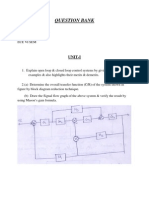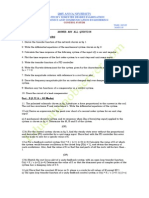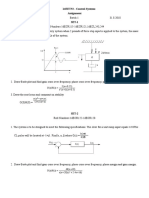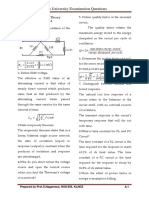CS ASS2 (13-17batch)
CS ASS2 (13-17batch)
Uploaded by
Anonymous yO7rcec6vuCopyright:
Available Formats
CS ASS2 (13-17batch)
CS ASS2 (13-17batch)
Uploaded by
Anonymous yO7rcec6vuOriginal Description:
Original Title
Copyright
Available Formats
Share this document
Did you find this document useful?
Is this content inappropriate?
Copyright:
Available Formats
CS ASS2 (13-17batch)
CS ASS2 (13-17batch)
Uploaded by
Anonymous yO7rcec6vuCopyright:
Available Formats
CONTROL SYSTEM (IC6501)
BATCH-2013-2017 (PROBLEMS FROM UNIT 2)
Assignment-1 D.O.A-17/08/15 D.O.S. 22/08/15
1.(a) The forward path transfer function of an unity feed back control system is
2
given by G ( s ) s ( s 3) . Obtain an expression for unit step response of the system.
1.(b) An unity feedback control system is shown in Fig below. By using derivative
control the damping ratio is to be made to 0.8. Determine the value of Td and compare
the rise time, peak time and maximum overshoot of the system. The input to the system
is unit step.
(i) Without derivative control
(ii) With derivative control.
1.(c) For the system shown in Fig, find the effect of PD controller with Td=0.1 on peak
overshoot and settling time when it is excited by unit step input.
1.(d) The open loop transfer function of a unity feedback system is given
K
by G(S) = Where K and T are positive constant. By what factor should the amplifier
S( S+1)
gain ‘K’ be reduced, so that the peak overshoot of unit steps response of the system is reduced
from 85% to 15%.
C ( s) 75
1.(e)A second order system is given by . Find its rise time, peak time, peak
2
R( s) S 6S 25
overshoot, settling time with respect to unit step input. Also obtain the expression for its
output response.
1.(f).A certain unity negative feedback control system has the following
K ( s 2)
forward path transfer function G(s) = s ( s 5)(4 s 1) . The input applied is r(t) = 1+3t, Find
the minimum value of K so that the steady state error is less than 1
Compiled by Prof.S.Nagammai,HOD/EIE Page 1
CONTROL SYSTEM (IC6501)
2.(a.)Figure shows PD controller used for a system. Determine the value of Td so that
system will be critically damped. Calculate its setting time.
2.(b).The unity feedback system is characterized transfer function
K
G(S )
s ( s 10) . Determine the gain K, so that the system will have a damping ratio
of 0.5. For this value of K, determine the setting time, peak overshoot and time to peak
overshoot for a unit step input.
2.(c). A unity feed back system is characterized by the open loop transfer function
1
G(s) = s (0.5 s 1)(0.2 s 1) . Determine the steady state error for Unit step, Unit ramp and Unit
acceleration unit. Also determine the damping ratio and natural frequency of the dominant
roots.
2.(d). Determine the unit step response of the control system shown in the following figure.
10
2.(e)An open loop transfer function of a servo system with unity feedback is G(s)= .
s(0.1s+1)
The input function is, r(t)=2 3t t . Determine the generalized error coefficient and steady
2
state error.
2.(f) Determine the steady state errors for the following inputs 5u(t), 5tu(t), 5t2u(t) to a
system whose open-loop transfer function is given by
[100( s 2)( s 6)]
G(S )
[( s ( s 3)( s 4)]
Compiled by Prof.S.Nagammai,HOD/EIE Page 2
CONTROL SYSTEM (IC6501)
3.(a) The unit impulse response of a unit feedback control system is given by
C (t ) tet 2et Find the open loop transfer function.
3.(b). For the system shown in Fig find the error using dynamic error coefficient for the
input polynomial r(t)=5+4t+7t2
3.(c)i).The open loop transfer function of a unity feedback control system is
K
given by G ( S )
s (1 sT ) . By what factor the amplifier gain ‘K’ be multiplied so that the
damping ratio is increased from 0.2 to 0.6
1
3.(c).ii) For a closed loop system with G(s) = s1 and H(s) = 5, calculate the generalized error
coefficients and find error series.
3.(d). The open loop transfer function of a servo system with unity feedback
10
is G( S ) S (0.1S a) . Evaluate the static error constants and steady state error of the system
when subjected to an input of r(t) = a0 +a1t +(a2/2)t2
3.(e) A positional control system with velocity feedback is shown in Fig. Determine the
response of the system for unit step input.
C(S ) 10
3.(f). Obtain the unit step and unit impulse response of the system R ( S ) S 2 2 S 10
Compiled by Prof.S.Nagammai,HOD/EIE Page 3
You might also like
- 2020 02. DNNRec A Novel Deep Learning Based Hybrid Recommender SystemNo ratings yet2020 02. DNNRec A Novel Deep Learning Based Hybrid Recommender System14 pages
- Mock Test 1: Time Domain Performance of I-Order & Ii-Order SystemsNo ratings yetMock Test 1: Time Domain Performance of I-Order & Ii-Order Systems8 pages
- Transient and steady state response ExercisesNo ratings yetTransient and steady state response Exercises2 pages
- QUESTION BANK of Control Systems Engineering PDFNo ratings yetQUESTION BANK of Control Systems Engineering PDF12 pages
- R.M.D Engineering College (An Autonomous Institution) Ec8391 - Control System Engineering Question BankNo ratings yetR.M.D Engineering College (An Autonomous Institution) Ec8391 - Control System Engineering Question Bank6 pages
- ĐỀ CƯƠNG ÔN TẬP PHẦN LÝ THUYẾT LTĐKTĐ - 2023-2024 - EN - Final - UploadNo ratings yetĐỀ CƯƠNG ÔN TẬP PHẦN LÝ THUYẾT LTĐKTĐ - 2023-2024 - EN - Final - Upload13 pages
- 02 CHN 303 ETE Question Paper 2022-23 01No ratings yet02 CHN 303 ETE Question Paper 2022-23 012 pages
- Module 4: Time Response of Discrete Time Systems: Lecture Note 1100% (1)Module 4: Time Response of Discrete Time Systems: Lecture Note 15 pages
- Exercise 3 (Transient Response Analysis)No ratings yetExercise 3 (Transient Response Analysis)2 pages
- Anna University Examination Questions: EE6201-Circuit Theory May - 2015No ratings yetAnna University Examination Questions: EE6201-Circuit Theory May - 20157 pages
- Anna University Examination Questions: EE6201-Circuit Theory NOV - 2015No ratings yetAnna University Examination Questions: EE6201-Circuit Theory NOV - 20159 pages
- Anna University Examination Questions: EE6201-Circuit Theory NOV - 2014No ratings yetAnna University Examination Questions: EE6201-Circuit Theory NOV - 20148 pages
- Anna University Examination Questions: EE6201-Circuit Theory May - 2014No ratings yetAnna University Examination Questions: EE6201-Circuit Theory May - 20148 pages
- Ei6801 - Computer Control of Process Part-A Answer All Questions (5x2 10)No ratings yetEi6801 - Computer Control of Process Part-A Answer All Questions (5x2 10)7 pages
- Name: Digital Logic Circuits (Common To ICE) Part A (20X2 40 Marks) Answer All QuestionsNo ratings yetName: Digital Logic Circuits (Common To ICE) Part A (20X2 40 Marks) Answer All Questions2 pages
- Ic6501 Control Systems: UNIT-1 (2 Mark Q/A)No ratings yetIc6501 Control Systems: UNIT-1 (2 Mark Q/A)6 pages
- K L N College of Engineering Pottapalaym: 1 Gshs S 100No ratings yetK L N College of Engineering Pottapalaym: 1 Gshs S 1002 pages
- R18B Tech MinorIVYearISemesterTENTATIVESyllabusNo ratings yetR18B Tech MinorIVYearISemesterTENTATIVESyllabus22 pages
- Time Series Anomaly Detection With Multiresolution Ensemble DecodingNo ratings yetTime Series Anomaly Detection With Multiresolution Ensemble Decoding9 pages
- Using YOLOV3: Armament Detection and Alerting SystemNo ratings yetUsing YOLOV3: Armament Detection and Alerting System5 pages
- Brief Introduction To Artificial Intelligence100% (6)Brief Introduction To Artificial Intelligence71 pages
- Andrei Barbu, Siddharth Narayanaswamy, and Jeffrey Mark Siskind School of Electrical and Computer EngineeringNo ratings yetAndrei Barbu, Siddharth Narayanaswamy, and Jeffrey Mark Siskind School of Electrical and Computer Engineering1 page
- Feedback and Control Systems: Activity No. 4 - Root Locus Analysis of Systems100% (1)Feedback and Control Systems: Activity No. 4 - Root Locus Analysis of Systems8 pages
- Process Modeling, Identificaion and ControlNo ratings yetProcess Modeling, Identificaion and Control20 pages
- Emoji2vec: Learning Emoji Representations From Their DescriptionNo ratings yetEmoji2vec: Learning Emoji Representations From Their Description7 pages
- NonlinearAdaptiveCtrl Midterm Exam 2nd Semester 1516No ratings yetNonlinearAdaptiveCtrl Midterm Exam 2nd Semester 15161 page
- Xgboost: A Scalable Tree Boosting System: Tianqi Chen Tqchen@Cs - Washington.Edu Carlos Guestrin Guestrin@Cs - Washington.Edu100% (1)Xgboost: A Scalable Tree Boosting System: Tianqi Chen Tqchen@Cs - Washington.Edu Carlos Guestrin Guestrin@Cs - Washington.Edu13 pages
- PHD Thesis Sound Event Detection With Weakly Labelled Data - v2.0No ratings yetPHD Thesis Sound Event Detection With Weakly Labelled Data - v2.0102 pages
- Simulation Modelling of A Fed-Batch Bioreactor For Controller Development100% (3)Simulation Modelling of A Fed-Batch Bioreactor For Controller Development116 pages











































































































